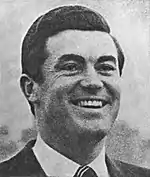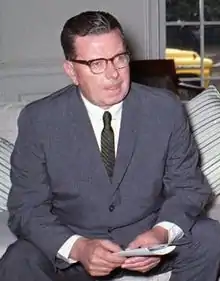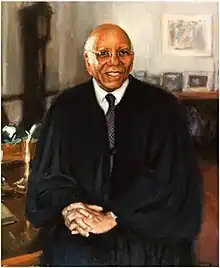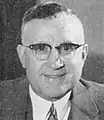Saint Joseph's University
Saint Joseph's University (SJU or St. Joe's) is a private Jesuit university in Philadelphia and Lower Merion, Pennsylvania. The university was founded by the Society of Jesus in 1851 as Saint Joseph's College. Saint Joseph's is the seventh oldest Jesuit university in the United States and the fourth largest university in Philadelphia. It is named after Saint Joseph.
 | |
| Latin: Universitas Sancti Iosephi | |
Former names | Saint Joseph's College (1851–1978) Philadelphia College of Pharmacy (1821-1998)[1] University of the Sciences (1998–2022)[2] |
|---|---|
| Motto | "Spirit, Intellect, Purpose" |
| Type | Private university |
| Established | September 15, 1851[3] |
| Founder | Felix-Joseph Barbelin |
| Accreditation | MSCHE |
Religious affiliation | Roman Catholic (Jesuit) |
Academic affiliations | |
| Endowment | $378.8 million (2021)[4] |
| President | Cheryl McConnell, PhD [5] |
| Provost | Brice R. Wachterhauser, PhD (Interim) |
Academic staff | 449[6] |
| Students | 6,779[6] |
| Undergraduates | 4,299 |
| Postgraduates | 2,480 |
Other students | 82 (adult and visiting students); over 9,000 post merger. |
| Location | , , United States 39°59′43″N 75°14′20″W |
| Campus | Large City, 149 acres (60.3 ha) |
| Newspaper | The Hawk Newspaper |
| Colors | Crimson and gray[7] |
| Nickname | Hawks |
Sporting affiliations | |
| Mascot | The Hawk |
| Website | www |
 | |
Saint Joseph's University has nearly 9,000 undergraduate, graduate, and doctoral students in over 135 undergraduate programs, 77 graduate programs, and 9 adult learner programs. It has 14 centers and institutes, including the Kinney Center for Autism Education and Support and the Pedro Arrupe, S.J., Center for Business Ethics.
Saint Joseph's athletics teams, the Hawks, are an NCAA Division I program that competes in the Atlantic-10 Conference and Philadelphia's Big 5. The official colors of the university are crimson and gray. The school mascot is The Hawk which never stops flapping its wings while in costume.
Jesuit and Catholic identity
Approximately 38 Jesuits live on campus with 10 serving as faculty. The university's Jesuit community lives in the Loyola Center, directly across the street from Barbelin Hall. The Loyola Center joins Manresa Hall, the infirmary for Jesuits. The property features the Ziff Carriage House, which serves as a meeting place and guest house. Other Jesuit residences include St. Alphonsus House (at 5800 Overbrook Avenue) and Faber Hall (39 Berwick Road). One Jesuit lives in a residence hall; the lay university president maintains an apartment in the Merion Gardens Apartment building.
The university extensively uses its Jesuit identity in its branding. It began the Magis ("greater") campaign in 2013 to highlight commitment to living "For the greater glory of God" (Ad maiorem Dei gloriam), the motto of the Society of Jesus.[8]
SJU also promotes the Jesuit principle of cura personalis or "care for the whole person." Undergraduates must complete a general education program that focuses heavily on traditional liberal arts disciplines. Every general education class is titled "154", which stands for the year AD 1540 when the Society of Jesus was accepted by the Pope.
On September 27, 2015, Pope Francis, a Jesuit, made a stop at the university during his two-day visit to Philadelphia.[9]
History
Beginning of Collegiate Jesuit Education in Philadelphia
St. Joe's, founded by the Jesuits in 1851 as Saint Joseph's College, is the seventh oldest Jesuit university in the United States and is named after the legal father of Jesus, Saint Joseph.[10]

Origin of North America's First College of Pharmacy
On June 1, 2022, Saint Joseph's University acquired University of the Sciences (aka USciences and fka Philadelphia College of Pharmacy), adding professional programs in health and science, including occupational therapy, physical therapy, pharmacy and physician assistant (as USciences had offered more than 30 degree and certification programs across a wide range of pharmaceutical and healthcare-related disciplines.[12]). Hence, St. Joe's can now trace its history to February 1821, when 68 apothecaries aka pharmacists met in Philadelphia's Carpenters' Hall to establish improved scientific standards and to develop programs to train more competent apprentices and students. They formalized their new association through a constitution, which declared their intent to establish a school of pharmacy to enhance their vocation and to "guard the drug market from the introduction of spurious, adulterated, deteriorated or otherwise mischievous articles, which are too frequently forced into it".[13] Classes began nearly immediately, making it the first institution of higher learning in the United States dedicated to the field of pharmacy.[14]
In 1825, the college began publishing the first academic journal in the United States dedicated to pharmacy. The apothecaries formalized their new association through a constitution, which declared their intent to establish a school of pharmacy to enhance their vocation and to "guard the drug market from the introduction of spurious, adulterated, deteriorated or otherwise mischievous articles, which are too frequently forced into it".[15]
Since Philadelphia College of Pharmacy (last known as University of Sciences in Philadelphia or USciences) was chartered in 1822, SJU, the successor to Philadelphia College of Pharmacy and USciences, is now the first institution of higher learning in the United States dedicated to the field of pharmacy.[16]
Campus locations of Philadelphia's first Jesuit college
St. Joe's college started on September 15, 1851,[17] when 36 students began classes in a building adjacent to Old St. Joseph's Church Roman Catholic church on Willings Alley, between South 3rd and South 4th Streets and Walnut and Spruce Streets in Philadelphia.[18]
St. Joe's moved in 1866 from Willings Alley to a full block on Girard Avenue between 17th and 18th Streets in Philadelphia (now the location of Saint Joseph's Preparatory School).[19]
St. Joe's moved to its present City Avenue Hawk Hill campus in November 1927 after St. Joe's raised over million dollars enabling the (i) purchase of twenty-three acres and (ii) construction of its modern collegiate Gothic architectural main academic building.[20]
Seal

The Seal of Saint Joseph's University signifies its history and values. Other Jesuit educational institutions share three of these symbols. The wolves over a kettle pot show the generosity of the Loyola family towards the poor. Tradition claims that the Loyolas provided so much food for their soldiers that even the wolves had enough to eat. IHS are the first three letters of the name of Jesus in Greek, and the historic monogram of the Society of Jesus. The stripes signify the 7 sons of the House of Loyola, who died defending their home. The lily is the distinguishing symbol of the university, honoring Saint Joseph, the school's patron saint. The seal is the graphical representation of Saint Joseph's and its Jesuit identity.
Presidents
On March 10, 2023, Saint Joseph's University's board of trustees elected Cheryl A. McConnell its 29th – and first female – president in the university's 172-year history, effective immediately. McConnell is a 35-year veteran of Jesuit higher education, having most recently served as Saint Joseph's interim president since last June, and as provost and chief academic officer for three years prior.[21]
Academics
The university has four schools and colleges that offer 224 academic programs and 9 degree-completion and post-baccalaureate certificate program.[22]
Of tenure-track faculty, 99% hold the highest possible degrees in their fields. The 2008 graduation rate was 90% and the freshman retention rate for the Class of 2017 is 89.8%. About 51% of undergraduates are enrolled in the College of Arts and Sciences while 49% are enrolled in the Haub School of Business.[23] The Carnegie Classification of Institutions of Higher Education classified Saint Joseph's among "Master's Colleges and Universities (larger programs)".
The university also has 14 centers and institutes, which include the Academy of Food Marketing, The Barnes Arboretum at Saint Joseph's University, Center for Addiction and Recovery Education, Center for Professional Development, Faith-Justice Institute, Institute for Environmental Stewardship, Institute for Jewish-Catholic Relations, Institute of Clinical Bioethics, Kinney Center for Autism Education and Support, Maguire Academy of Insurance and Risk Management, Pedro Arrupe, S.J., Center for Business Ethics, Philadelphia Regional Institute for STEM Educators and Substance Use Disorders Institute.
Honors program
The university has an undergraduate honors program, housed in Claver House.[24]
Campus

Saint Joseph's University's campus, often referred to as Hawk Hill, is located on City Avenue, which splits the university between the western edge of Philadelphia and Lower Merion Township. Portions of the property are in the Lower Merion side.[25]
The university's official mailing address is in Philadelphia. A bridge that spans City Avenue connects the two sides of the campus. Its 103 acres (0.42 km2) are concentrated from Cardinal Avenue to 52nd Street and Overbrook Avenue to City Avenue. The university also owns several buildings that are not on the main campus. With the acquisition of the Maguire Campus, one half of the 114 acres (0.46 km2) are located on the Lower Merion side of City Avenue. In all, there are 92 buildings on the university's campus.[26]
St. Joe's is within 15 miles (24 km) of La Salle University, Harcum College, Rosemont College, Philadelphia College of Osteopathic Medicine, University of Pennsylvania, Drexel University, Temple University, Swarthmore College, Bryn Mawr College, Haverford College, Philadelphia University, Eastern University, Cabrini College, and Villanova University. SEPTA regional rail train stations on each side of campus provide students with easy access to Center City.
Main campus
The main campus is located on the Philadelphia side of City Avenue between Cardinal and Overbrook Avenues and 52nd Street, and is the original location of the university when it moved to City Avenue in 1927. Saint Joseph's most recognizable building is Barbelin Hall, opened in 1927. The hall is known for its Gothic architecture, particularly the gargoyles that mark what is called the Barbelin Quadrangle (or Barbelin Courtyard) and the tall, four-spired bell tower that can be seen from miles away. The bell tower that sits atop Barbelin served as the university's logo for several years. Barbelin Hall was built by John McShain who would later go on to construct many buildings in Washington, D.C., such as The Pentagon and The Jefferson Memorial.[27]

Main campus contains the majority of academic buildings, first-year residence halls, and campus houses. Barbelin (College of Arts & Sciences), Mandeville (Haub School of Business), Bellarmine, Post, and Science Center comprise the main academic halls. Campus houses are a prominent feature of main campus serving as departmental offices for fine arts (Boland Hall), communication studies (Bronstein Hall), and the president and provost (Regis Hall), as well as several housing options for first-year students and upperclassmen. Green spaces on campus include St. Mary's, Claver House, and Wolfington lawns located on the Main Campus, in addition to two quadrangles, College Hall Quad and Barbelin Quad.
The Post Academic Center is the university's main library, the result of a renovation of the original Francis A. Drexel Library and an expansion project called the Post Learning Commons, from 2011 to 2013. Drexel Library and Post Learning Commons are connected via a glass atrium and bridge through the heart of campus. Post Academic Center houses approximately 355,000 volumes, 1,450 print journals, 15,000 full-text electronic journals, 2,800 e-books, 866,000 microforms, and 4,975 audio-visual materials. Unique to the Post Academic Center is the Campbell Collection in Food Marketing.[28]
Campion Student Center is the hub for student activities, student life administrative offices, and dining facilities. The building was renovated in 2008 and now includes the main dining hall; a food court featuring Grille Works, Subway, and Hawk Wrap; and the C-Store. The student center also features the Doyle Banquet Halls, Forum Theater, and President's Lounge used for larger gatherings and lectures on campus. Located just off Campion Student Center is Simpson Hall, which houses the Student Media Center and The Perch, a 24-hour student lounge.
In September 2012, the university purchased the adjacent Cardinal's Residence on 54th and Cardinal Avenue from the Archdiocese of Philadelphia.[29] Beginning with the fall 2014 semester, the Cardinal's Residence was renamed 5800 City Ave. It serves as a welcome center for prospective families and has offices for all enrollment management operations.
James J. Maguire '58 Campus
On August 8, 2008, Saint Joseph's completed the acquisition of the adjacent Episcopal Academy after purchasing the property in 2005. The new 38-acre area (150,000 m2) was named the Maguire Campus for the lead donor, Saint Joseph's alumnus James Maguire. The Maguire Campus is located directly across from the Main Campus on the Lower Merion side of City Avenue. The Maguire Campus features three main academic buildings: Merion Hall, Connelly Hall, and Toland Hall. Merion Hall is the largest of the three, and includes the University Gallery.
The Cardinal John Foley Center, a multi-use space, hosts lectures, concerts, and social gatherings, in addition to large-scale admission events. The Kinney Center for Autism Education and Support, established in 2009, was made possible with donations totaling over $8 million, and is located in Connelly Hall. Duperreault, Quinn, and Windrim Halls are campus houses serving as administrative space for University Advancement.
Athletic facilities include the Michael A. O'Pake, Esq. '61 Recreation Center, Ellen Ryan Field (field hockey), John Smithson Field (baseball), Curran Lawn, and a softball field.
Along with all of the buildings and fields, the Maguire Campus adds over 300 parking spaces for faculty and students, and a number of acres will be turned into green space. There are over 600 different species of trees on the Maguire Campus.
Overbrook Campus
The Overbrook Campus is located about a mile from and Main Campus, near Overbrook Train Station. Here also Saint Joseph's University owns buildings on both sides of City Avenue. Currently the campus holds six dorms, reserved exclusively for sophomores, juniors, and seniors. These dorms are Ashwood Apartments, Wynnewood Hall, Merion Gardens Apartments, Pennbrook Apartments, Morris Quad Townhouses, and Moore Hall. The campus also holds the Alumni House.[26]
Although it is located about a mile from the main campus, Saint Joseph's University runs shuttles every 30 minutes (and 15 minutes during peak hours) to accommodate students.
Housing
Approximately 80% of students at Saint Joseph's live on campus. Housing options include residence halls, apartments, townhouses, and campus houses.
First-year students can choose from traditional residence halls (McShain Hall and Villiger Hall), suite-style residence halls (Sourin Residence Center and LaFarge Residence Center), or campus houses (Tara and Quirk Halls). Villiger Hall, the university's newest residence, opened in August 2012. All first-year housing options are located on the main campus. Sophomores, juniors, and seniors can choose to live in several campus houses or apartments. Additionally, by Fall 2022, the university is set to open a new residence hall specifically for students on the Autism spectrum.[21]
Current developments and plans
During a presentation to the faculty in April 2013, President Kevin Gillespie, S.J., announced that, partially thanks to the popular Magis campaign, the university was beginning to expand, as it has a freshman class of 1,300 students enrolled for the fall of 2013. By 2017, it hoped to enroll 6,000 undergraduate students.[30]
The university is heading into the final leg of its strategic plan, Plan 2020: Gateway to the Future, focused on increased academic distinction, facility enhancements, and endowment growth. The university has raised over $12.1 million and created 40 new scholarships under President Gillespie's Magis Scholarship Initiative.[31] In 2023, St. Joseph's announced the acquisition of the University of the Sciences.[32]
Larger campus enhancement projects include a new dining hall and black box theatre on Maguire Campus, and an expansion of Mandeville Hall currently on hold due to funding concerns.[33]
Additional projects include an acquisition of the Arboretum of the Barnes Foundation, which is adjacent to the university's campus in Lower Merion Township. The proposed acquisition is currently pending in the Montgomery County Orphans' Court, and would be a significant addition to the university. Should this be accepted, the university would offer a horticulture minor program, as well as provide a fine arts gallery, including murals by famed artist Henri Matisse. This expansion has been largely possible due to a historical $50m gift made in 2017 by alumnus James Maguire ('58).
In March 2022, the university's planned merger with the University of the Sciences was approved by the Middle States Commission on Higher Education.[34] The merger took effect on June 1, 2022, and university president Mark Reed told Axios he was not ruling out future mergers and acquisitions.[35]
Student life
Demographics
Saint Joseph's 8,860 students come from all over the United States, with most from the Northeast, including Pennsylvania.[36] Of these students 4,670 are traditional undergraduates, while the university's graduate and professional student population is numbered at 3,580.[36]
| Undergraduate | Professional | 2010 U.S. census | |
|---|---|---|---|
| American Indian/Alaskan Native | .01% | .02% | .9% |
| Asian | 2.2% | 1.2% | 4.8% |
| Black/African American | 2.9% | 39.2% | 12.6% |
| Hispanics of any race | 4.7% | 5.5% | 16.4% |
| Pacific Islander/Native Hawaiian | .01% | .02% | .5% |
| White/non-Hispanic | 85.3% | 40.9% | 63.7% |
| Two or more races | 1.4% | 1.1% | 2.9% |
| Unknown | 1.9% | 10.3% | N/A |
The student body is 51.5% female and 48.5% male.[36] The retention rate for Saint Joseph's is high, with about 88.3% of students returning for their sophomore year.[36] 74% of students graduate within four years,[36] due in part to the student-faculty ratio, which is 14:1. 39.7% of classes have fewer than 20 students.[36]
Admissions
The overall acceptance rate is 58.3%, with early action acceptance at 68.4%.[36] The average freshman retention rate is 88.3%.[36]
Of the Class of 2013, 94% were either employed, pursuing graduate studies, or involved in full-time volunteer programs within six months of graduation.[41] The average starting salary was $48,400 for the Class of 2013, while the average graduate student from the Class of 2013 received $13,600 in scholarships.[41]
Beginning with the Class of 2014 high school graduates, Saint Joseph's University is test optional. This means that it does not require applicants to submit SAT or ACT test scores, although applicants may choose to submit these scores. The university's program is a four-year test program that was scheduled to be reassessed in 2017.[42]
In the summer of 2014, John Haller, associate provost for enrollment management at Saint Joseph's, discussed the progress of the SAT optional program. For the class of 2018, applications increased by 8 percent to 8,500. About 18 percent of those applicants chose not to submit test scores. Of the incoming fall 2014 freshman class of 1,350, one in five was admitted without having submitted test scores. Haller also noted that the average GPA for the class was identical to the previous year's class.[43]
Organizations
Saint Joe's has 100 student organizations.[6] It has 20 NCAA Division 1 Athletic programs, 30 clubs and intramural sports, and fitness programs. It competes in the Philadelphia City 6 Extramural Classics.[44] The women's ice hockey team is a club sport at Saint Joe's, but is recognized by the Delaware Valley College Hockey Conference (DVCHC) as a Division III sport.[45] Organizations include national fraternities and sororities; a radio station; two newspapers, The Hawk and the HawkEye; the Student Union Board; the Student Senate; and the Student Concert Committee.[44] The Villiger Debating Society is the university's debating society.
Publications and media
Saint Joseph's University publishes the official alumni SJU Magazine three times a year. Standalone magazines are published once a year for the Haub School of Business (Haub School Review) and College of Arts and Sciences (Intellect). The Hawk, the university's student newspaper, is published weekly during the fall and spring semester. Students that take a class called news reporting is the writers in the hawk and also the members of the club are writers. The Hawk is fully run by students with help from the professors. This is a club and class that prepares you for journalism and editorial skills in the future. The Crimson and Gray Literary Magazine showcases the best of student fiction, poetry, and artwork in an annual publication; students and faculty may download the magazine for free (from the organization's website) or pick one up from select locations around campus.[46] The Drexel Library has a newsletter called Library Lines.[47] The Saint Joseph's University Press prints books and articles written by faculty and other authors.[48]
Radio 1851
Radio 1851 is Saint Joseph's University's student-run radio station and plays a variety of genres, including indie rock, rap/hip-hop, country, and electric dance music. The station began in 1922 as WSJR,[49] the first college radio station to broadcast on AM, and moved to FM in the 80s.
Greek life
Saint Joseph's University recognizes eight social Greek organizations and two co-educational, professional Greek organizations. Approximately 21% of undergraduates are affiliated with a social fraternity or sorority.[50] No Greek housing is provided by the university.
Active social fraternities
| National fraternity | Greek letters | Chapter | Opened |
|---|---|---|---|
| Lambda Chi Alpha | ΛΧΑ | Phi Lambda | May 29, 1978 |
| Sigma Pi | ΣΠ | Theta Chi | April 14, 2007 |
| Sigma Phi Epsilon | ΣΦΕ | Pennsylvania Psi | November 12, 1988 |
Social sororities
| National sorority | Greek letters | Chapter | Opened |
|---|---|---|---|
| Alpha Gamma Delta | ΑΓΔ | Zeta Pi | February 7, 1987 |
| Alpha Omicron Pi | ΑΟΠ | Sigma Beta | February 5, 2005 |
| Sigma Sigma Sigma | ΣΣΣ | Delta Psi | November 18, 1983 |
| Alpha Phi | ΑΦ | Theta Theta | October 10, 1992 |
| Phi Sigma Sigma | ΦΣΣ | Iota Rho | Fall 2013 |
No sorority has ever been closed or otherwise dormant.
Professional and honorary fraternities
| National fraternity | Greek letters | Chapter | Opened | Focus | Notes |
|---|---|---|---|---|---|
| Delta Sigma Pi | ΔΣΠ | Zeta Pi | 1965 | Business | This chapter was closed in 1982 and re-opened in 2003. |
| Phi Sigma Pi | ΦΣΠ | Zeta Iota | April 17, 2011 | Honor | |
| Alpha Kappa Psi | ΑΚΨ | Chi Delta | October 28, 2017 | Business | |
Athletics
| Men's sports | Women's sports |
|---|---|
| Baseball | Basketball |
| Basketball | Cross country |
| Cross country | Field hockey |
| Golf | Lacrosse |
| Lacrosse | Rowing |
| Rowing | Soccer |
| Soccer | Softball |
| Tennis | Tennis |
| Track and field† | Track and field† |
| † – Track and field includes both indoor and outdoor | |
Saint Joseph's University is the home of the Hawks, its athletics program. The school colors are crimson and gray. SJU fields teams in 20 varsity sports in Division I of the National Collegiate Athletic Association. The Hawks are part of the Atlantic 10 Conference. Since the Atlantic 10 does not support men's lacrosse, the Hawks play in the Northeast Conference for that sport only.
Along with the Atlantic 10, Saint Joseph's is a member of the Philadelphia Big 5, which intensifies local rivalries within Philadelphia city schools. Its effect on Saint Joseph's causes intense games with Temple University, Villanova University, the University of Pennsylvania, and inter-conference rival LaSalle University.
Saint Joseph's is also a member of the City 6. Similar to the Big 5, the City 6 comprises the entire Philadelphia Big 5 plus Drexel University, which did not participate in Division I athletics until 1973. In addition to official team rivalries, the local colleges also compete in various extramural sporting events to crown a City 6 Champion.
The Hawk mascot
One of the most famous mascots in college sports, the Saint Joseph's Hawk has been flapping its wings for over 50 years. Jim Brennan originated the idea for a hawk as mascot during the 1954–1955 season. Brennan, a former Marine and SJU cheerleader, at first wanted to secure an actual hawk, but later switched to the costume idea. The student government raised the $120 needed to buy the initial costume, which Brennan donned for three years. He made his debut as the Hawk on January 4, 1956, at a 69–56 win over La Salle University at the Palestra.[51]
The Hawk is best known for staying in constant motion by flapping its wings throughout every basketball game, and for representing the Saint Joseph's motto, "The Hawk Will Never Die". It is also recognized by its "flying" in figure eights around the court during timeouts.[51]
Men's basketball
While Saint Joseph's fields 20 NCAA sports, the university's most popular sport is men's basketball. Saint Joseph's has a rich basketball tradition. Most home games are played at Hagan Arena on the school's campus, while some games are played at the Palestra on the University of Pennsylvania campus.
Saint Joseph's major rival is Villanova University. The rivalry is known as the Holy War, although starting in 2013 both schools requested that the media refrain from using the term.[52] The school also maintains intense rivalries with the other Philadelphia universities.
Fans of the Hawks often chant "The Hawk Will Never Die!". Since the school's undefeated regular season, this chant has gained familiarity with the team's opponents. In 2003, Sports Illustrated listed that cheer among "The 100 Things You Gotta Do Before You Graduate (Whatever the Cost)", calling it "the most defiant cheer in college sports."[53]

Athletic facilities


- John Smithson Field: Named after alum and former interim president John Smithson, the Hawks on-campus baseball field opened in 2012 on Maguire Campus. It features a synthetic surface with a dirt pitching mound and an AstroTurf 3D GameDay Grass surface. Bleacher seating capacity is 400 with much more space for standing room only.
- SJU Softball Field: The softball team opened their on-campus field in 2012. It features a turf outfield and bleacher seating for 400 spectators.
- Robert Gillin Jr., Boathouse: Saint Joseph's University celebrated its sesquicentennial anniversary in 2000–01. In conjunction with that celebration, the SJU Rowing Program, along with Saint Joseph's Prep, kicked off a capital campaign to finance the construction of a state-of-the-art boathouse on the Schuylkill River. The boathouse provides a permanent home for the Hawk rowing programs. In addition, it provides the university with a significant presence on Kelly Drive. Named in honor of Robert Gillin Jr., groundbreaking for the facility took place in the fall of 2001. The total cost for the project was approximately $3 million, plus an endowment fund to support ongoing operational costs.
- Sweeney Field: Laid out in a natural bowl in the center of Saint Joseph's campus, Sweeney Field (formerly known as Finnesey Field) is the home field of Hawk soccer, lacrosse, and field hockey teams. Originally constructed for football and opened in 1929 with plans for an eventual 70,000-seat stadium, the field has undergone numerous changes over the years.
- Tennis Complex at the Maguire Campus: The tennis team moved to the six refurbished courts on the Maguire Campus in 2009 with the first SJU Invitational.
- Finnesey Courts: Adjacent to Sweeney Field stand the Finnesey Courts and home to the Hawk men's and women's tennis teams from the late 1940s until 2009. Prior to that SJU primarily played its home matches at the nearby Narberth courts. When courts were first built on campus, they were located where Bellarmine Hall now stands. Due to Bellarmine's construction in the summer of 1960, however, the Finnesey courts were torn down and rebuilt in their current location. These courts are still used by students.

- Michael J. Hagan Arena: The on-campus home of the Hawks basketball teams was originally named Alumni Memorial Fieldhouse for the Saint Joseph's graduates who gave their lives in World War II. The building was officially dedicated on November 11, 1949, and two weeks later played host to its first basketball game, a 62–46 loss to Rhode Island on November 26. Following that initial setback, SJU would go on to win the next 23 games in the friendly confines of the Fieldhouse. Overall, the Hawks have compiled an impressive 305–76 record (80.0 winning percentage) on Hawk Hill. Among the highlights of the Hawks' home court advantage was a 34-game winning streak from the late 1950s to the early 1960s, an 11–0 record in 2000–01, and the unbeaten 11–0 mark as the Hawks made their perfect season run in 2003–04. All told, SJU has had only two losing records in the Fieldhouse over 57 seasons. The Fieldhouse held 3,200 fans but the arena has a capacity of 4,200. Martin Luther King Jr., spoke at the Fieldhouse in the 1960s.[54]
- Ellen Ryan Field: The Field Hockey team returned to campus after a multi-year hiatus with the addition of Ellen Ryan Field on the Maguire Campus in 2011. Ryan Field has a synthetic AstroTurf12 pitch and is situated adjacent to City Avenue.
The university also has a 240 by 120 four-court multi-purpose area for basketball, tennis, and volleyball, an indoor four-lane 200-yard (180 m) jogging track, an 8-lane 25-meter indoor pool with a 300-seat observation area, four racquetball courts, locker rooms and saunas, a large fitness center, and nine outdoor tennis courts. The Maguire Campus includes another two gyms, a pool, and a weight room; this has been renamed to the O'Pake Athletic Center.
Alumni
As of 2008 there are over 60,000 living alumni of Saint Joseph's who live in all 50 states and in 59 countries.[55][56]



 Jamie Moyer, former MLB pitcher
Jamie Moyer, former MLB pitcher Bruiser Flint, college basketball coach
Bruiser Flint, college basketball coach
 Keith Leaphart, entrepreneur and physician
Keith Leaphart, entrepreneur and physician

_(cropped).jpeg.webp) Jack Ramsay, former NBA basketball coach
Jack Ramsay, former NBA basketball coach
.jpg.webp) Katie McGinty, former Chair of the Council on Environmental Quality
Katie McGinty, former Chair of the Council on Environmental Quality Muffet McGraw, former women's college basketball coach
Muffet McGraw, former women's college basketball coach Jameer Nelson, former NBA basketball player
Jameer Nelson, former NBA basketball player
 Frank LoBiondo, former U.S. Congressman
Frank LoBiondo, former U.S. Congressman William A. Barrett, U.S. representative from Philadelphia (1945-1947), (1949-1976)
William A. Barrett, U.S. representative from Philadelphia (1945-1947), (1949-1976)
See also
References
- "College of Apothecaries Charter". The National Gazette. March 30, 1821. p. 1; col. 3. Archived from the original on June 18, 2022. Retrieved October 23, 2020 – via Newspapers.com.
- "Histories Intertwined - 1950-2000". sju.edu. Archived from the original on June 2, 2022. Retrieved June 4, 2022.
- "Our History". Archived from the original on February 4, 2023. Retrieved February 4, 2023.
- As of May 31, 2021. 2020-2021 University Report (PDF) (Report). Saint Joseph’s University. February 19, 2021. Retrieved January 22, 2022.
- SJU (March 10, 2023). "Cheryl A. McConnell, PhD, Elected First Woman To Lead Saint Joseph's University". sju.edu. Archived from the original on March 10, 2023. Retrieved March 10, 2023.
- SJU. "SJU: Facts and Figures". sju.edu. Archived from the original on December 14, 2014. Retrieved December 6, 2014.
- Saint Joseph's University Brand Guidebook (PDF). September 1, 2017. Archived (PDF) from the original on December 20, 2019. Retrieved February 9, 2018.
- Saint Joseph's University. "Jesuit Identity". Archived from the original on March 31, 2019. Retrieved March 2, 2014.
- SJU. "Pontiff Makes Historic Visit to Philadelphia's Jesuit University". Archived from the original on June 12, 2016. Retrieved September 27, 2015.
- https://www.sju.edu/history-mission/our-history#:~:text=Saint%20Joseph's%20University%20traces%20its,blocks%20from%20iconic%20Independence%20Hall
- Boff, Leonardo (2009). Saint Joseph: The Father of Jesus in a Fatherless Society. Wipf and Stock Publishers. p. 34. ISBN 9781606080078.
Legal father, because he cohabits with Mary, Jesus' mother. Through this title Mary is spared from false suppositions and Jesus from spurious origins.
- Snyder, Susan (June 1, 2022). "The devil is dead. The hawk lives on. USciences is officially part of St. Joseph's University". The Inquirer. Retrieved June 1, 2022.
- "College of Apothecaries Charter". The National Gazette. March 30, 1821. p.1; col. 3. Retrieved October 23, 2020 – via Newspapers.com.
- "PCP Pennsylvania Historical Marker". explorehistory.com. Retrieved October 8, 2020.
- "College of Apothecaries Charter". The National Gazette. March 30, 1821. p. 1; col. 3. Retrieved October 23, 2020 – via Newspapers.com.
- "PCP Pennsylvania Historical Marker". explorehistory.com. Retrieved October 8, 2020.
- ""History of SJU", St. Joseph's University". Archived from the original on July 7, 2015. Retrieved July 27, 2015.
- https://www.sju.edu/history-mission/our-history
- https://www.sju.edu/magazine/special-edition/histories-intertwined
- https://www.sju.edu/magazine/special-edition/histories-intertwined accessed September 11, 2023
- "Cheryl A. McConnell, PhD, Elected First Woman To Lead Saint Joseph's University". sju.edu. March 10, 2023. Archived from the original on March 10, 2023. Retrieved March 10, 2023.
- "Facts & Figures". Archived from the original on September 29, 2022. Retrieved September 29, 2022.
- "Facts & Figures". Saint Joseph's University. Archived from the original on September 29, 2022. Retrieved September 29, 2022.
- SJU. "Saint Joseph's University Honors Program". sju.edu. Archived from the original on May 17, 2008. Retrieved September 22, 2008.
- "2020 CENSUS - CENSUS BLOCK MAP: Lower Merion township, PA" (PDF). U.S. Census Bureau. p. 4 (PDF p. 5/5). Archived (PDF) from the original on December 20, 2022. Retrieved December 19, 2022.
Saint Joseph's Univ
- "SJU: Campus Map" (PDF). sju.edu. Archived (PDF) from the original on September 24, 2015. Retrieved March 2, 2014.
- Hennelly, Meghan. "Figures on Barbelin immortalize past presidents and 1920s culture". sju.edu. Archived from the original on March 7, 2009. Retrieved March 9, 2009.
- "Facts & Figures | Saint Joseph's University". sju.edu. Archived from the original on July 18, 2019. Retrieved May 2, 2015.
- "SJU, Archdiocese Sign Letter of Intent for Purchase of the Cardinal's Residence | Saint Joseph's University". www.sju.edu. Archived from the original on August 7, 2016. Retrieved May 2, 2015.
- Rizzolino, Taylor (May 1, 2013). "Magis Campaign a Success?". The Hawk Newspaper.
- "Donor Inspiration Advances President's Magis Scholarship Initiative | SJU President's Message – Winter 2015". presidentreport.sju.edu. Archived from the original on April 17, 2015. Retrieved May 2, 2015.
- "Saint Joseph's University plans second acquisition in 2 years". Archived from the original on January 28, 2023. Retrieved January 28, 2023.
- "Mandeville addition on hold". Archived from the original on February 13, 2015. Retrieved May 2, 2015.
- Snyder, Susan (March 15, 2022). "St. Joe's merger with USciences is approved by Middle States Commission on Higher Education". The Philadelphia Inquirer. The Philadelphia Inquirer, LLC. Archived from the original on March 18, 2022. Retrieved March 18, 2022.
- D'Onofrio, Mike (June 3, 2022). "St. Joseph's University merges with University of the Sciences". Axios. Archived from the original on June 3, 2022. Retrieved June 3, 2022.
- U.S. News & World Report. "Saint Joseph's University". U.S. News & World Report. Archived from the original on March 5, 2014. Retrieved March 7, 2014.
- "Degree Student Head Count: Fall 2010" (PDF). Saint Joseph's University. Archived from the original (PDF) on March 8, 2014. Retrieved March 7, 2014.
- See Demographics of the United States for references.
- "Fall Headcount Enrollment, 2008-2012" (PDF). The Office of the Provost. Archived from the original (PDF) on December 16, 2013. Retrieved December 16, 2013.
- "Overview of Race and Hispanic Origin: 2010" (PDF). Archived from the original on May 5, 2011. Retrieved May 8, 2013.
- SJU. "SJU: Results & Outcomes". sju.edu. Archived from the original on May 3, 2016. Retrieved March 1, 2014.
- SJU. "SJU: Test Optional". sju.edu. Archived from the original on September 22, 2020. Retrieved March 1, 2014.
- Snyder, Susan. "Bryn Mawr to drop SAT requirement for admission". philly.com. Archived from the original on August 27, 2021. Retrieved July 26, 2014.
- "SJU: Campus Life". sju.edu. Archived from the original on July 18, 2019. Retrieved March 1, 2014.
- "Home". DVCHC Women's. Archived from the original on May 7, 2021. Retrieved March 13, 2020.
- SJU. "Crimson and Gray Literary Magazine Home Page". sju.edu. Archived from the original on February 24, 2009. Retrieved November 25, 2008.
- SJU. "Library Lines" (PDF). sju.edu. Archived from the original (PDF) on October 2, 2008. Retrieved September 22, 2008.
- SJU. "Saint Joseph's University Press". sju.edu. Archived from the original on September 1, 2000. Retrieved September 22, 2008.
- Galligan, Daniel. "Hawk Radio". sju.edu. Archived from the original on May 1, 2001. Retrieved September 22, 2008.
- "SJU: Student Life - Student Leadership & Activities - Greek Life". www.sju.edu. Archived from the original on April 30, 2015. Retrieved May 2, 2015.
- SJU. "The Hawk". sju.edu. Archived from the original on March 30, 2019. Retrieved March 23, 2014.
- Jensen, Mike. "Seeking an end to 'Holy War'". The Philadelphia Inquirer. Archived from the original on March 4, 2016. Retrieved March 23, 2014.
- "The 100 Things You Gotta Do Before You Graduate (Whatever the Cost)". Sports Illustrated. Archived from the original on February 3, 2013. Retrieved September 22, 2008.
- SJU. "SJU: Facilities". sju.edu. Archived from the original on September 17, 2008. Retrieved September 22, 2008.
- SJU. "SJU Alumni" (PDF). sju.edu. Archived from the original (PDF) on June 27, 2008. Retrieved September 22, 2008.
- "Barrett, William A.", OurCampaigns, archived from the original on August 8, 2022, retrieved August 7, 2022
